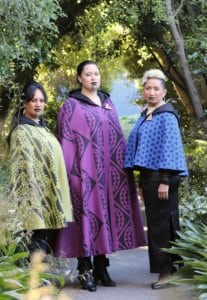 Raewyn Tauira Paterson is an artist whose work explores our relationship with the environment and ecology. The platform for this research is whanaungatanga, whakapapa and identity (Tuhoe and pakeha) with a focus on pattern and marae spaces. Raewyn has a passion for building community through art events and collaboration such as the Tuakana/Teina Exhibition at the Hastings Community Art Centre in 2016. She also works as Maori mentor across all levels of the degree at EIT. Raewyn has just completed her masters Te Hono ki Toi at EIT where she researched the relationship between the cultural space of the Marae and pattern in the suburban.
Raewyn Tauira Paterson is an artist whose work explores our relationship with the environment and ecology. The platform for this research is whanaungatanga, whakapapa and identity (Tuhoe and pakeha) with a focus on pattern and marae spaces. Raewyn has a passion for building community through art events and collaboration such as the Tuakana/Teina Exhibition at the Hastings Community Art Centre in 2016. She also works as Maori mentor across all levels of the degree at EIT. Raewyn has just completed her masters Te Hono ki Toi at EIT where she researched the relationship between the cultural space of the Marae and pattern in the suburban.
Based on Johnson Witehira’s observation that prior to colonisation, Maori Visual Culture was ubiquitous, her masters project Whare Sweet Whare explored ways to incorporate Maori imagery and design into the home. Within the wharenui, visual culture surrounds and immerses and it was this quality that she wanted to create in the everyday home. As such, her research has centred on elements such as wallpaper and soft furnishings textiles. Through a process of research models, she has focused on utilising the miniature, and explored ways to express notions of immersion within the space of a dolls house.
Another focus for Raewyn’s research has been the development of Maori patterns for clothing. This has involved extensive investigation into the historical and modern use of pattern on garments and textiles. The Kape collection draws from the legacy of the late Whetu Tirikatene-Sullivan’s wardrobe, and explores style and natural fibres that reference the customary cloak. The hand printed patterns experiment with the forms of the kape and the triangle, using repetition, reflection, positive and negative spaces to trigger memory of the wharenui. She has developed designs that range from the more familiar to transitional and experimental designs.
Recent exhibitions this year have included Iwi Toi Kahungunu at Hastings City Art Gallery where the Kape collection was exhibited. Also the work Braid was included as part of the Tūturu installation in the MTG, Napier. This work explores relationship with landscape, in particular the braided pathways of our local rivers.
